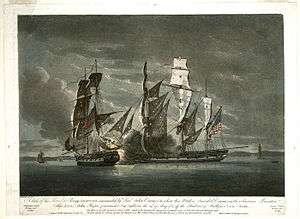Nova Scotia in the American Revolution
Nova Scotia was heavily involved in the American Revolution (Nova Scotia included present-day New Brunswick until this colony was created after the war).[5] The American Revolution (1776–1783) had a significant impact on shaping Nova Scotia. At the beginning, there was ambivalence in Nova Scotia, "the 14th American Colony" as some called it, over whether the colony should join the Americans in the war against Britain. Largely as a result of American Privateer attacks on Nova Scotia villages, as the war continued, the population of Nova Scotia solidified their support for the British. Nova Scotians were also influenced to remain loyal to Britain by the presence of British military units, judicial prosecution by the Nova Scotia Governors and the efforts of Reverend Henry Alline.
Context
In Nova Scotia a number of former New England residents objected to the Stamp Act 1765, but recent British immigrants and London-oriented business interests based in Halifax, the provincial capital were more influential. The only major public protest was the hanging in effigy of the stamp distributor and Lord Bute. The act was implemented in both provinces, but Nova Scotia's stamp distributor resigned in January 1766, beset by ungrounded fears for his safety. Authorities there were ordered to allow ships bearing unstamped papers to enter its ports, and business continued unabated after the distributors ran out of stamps.[6]
1775–1778
At the outbreak of the American Revolution, many Nova Scotians were New England-born and were sympathetic to the American Patriots. This support slowly eroded over the first two years of the war as American Privateers attacked Nova Scotian villages and shipping to try to interrupt Nova Scotian trade with the American Loyalists still in New England. During the war, American privateers captured 225 vessels either leaving or arriving at Nova Scotia ports.[7] In June 1775, the Americans had their first naval victory over the British in the Battle of Machias. In response to this defeat, in July 1775, the British sent from Halifax two armed sloops to Machias to capture the rebels. American privateer Joseph O'Brien captured these two British vessels on 12 July 1775 in the Bay of Fundy.[8] The following month American privateers from Machias executed their third consecutive victory in the region by raiding St John.[9][lower-alpha 1]
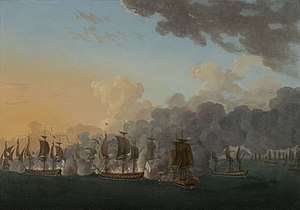
In retaliation for the American victories at Machias and St. John, the British executed the Burning of Falmouth (present-day Portland, Maine) in October 1775.[10] The following month, in November 1775, the American Patriots retaliated by ships Hancock and Franklin from Marblehead conducting the Raid on Charlottetown (1775) and Canso, Nova Scotia where they took five prizes. (In the raid on Charlottetown, the privateers also sought revenge against Nathaniel Coffin, the Loyalist who cut down the Liberty Tree in Boston.) The first year of the war ended with the American privateer Raid on Yarmouth, Nova Scotia.[11]
In 1775, rebellion began to ferment within Nova Scotia. Governor Legge began to target prominent Protestant dissenters of the St. Matthew's Church: John Fillis and judge William Smith and John Frost (minister). The Governor also targeted judge Seth Harding (judge) from the Liverpool Township and he left on October 1775 and did not return.[12][13] According to Cahill, as a result of "instances of non-legal repression and petty tyranny, such as the summary dismissals of Judge Smith and Justice Frost, had ended with the recall of Governor Legge [to London] in January 1776."[14]
A small number of Nova Scotians went south to serve with the Continental Army against the British; upon the completion of the war these rebels were granted land in the Refugee Tract in Ohio.[15]
In 1776, there was also armed rebellion such as the Maugerville Rebellion (1776). The other attack was by land and led by Jonathan Eddy who led the Battle of Fort Cumberland.[11] According to historian Barry Cahill, this rebellion led the Nova Scotia government to "use the formal law in sedition trials for an essential aspect of the official response to the American Revolution."[14] The government arraigned dissenters John Seccombe and jailed Timothy Houghton for sedition (incitement to rebellion).[16][17] Malachy Salter was convicted of sedition in 1777.
At the end of 1776, there were two significant American attacks on Nova Scotia. One of these assaults was by sea and led by John Paul Jones in the Raid on Canso (1776). In 1776, John Allan led the Maliseet to challenge the loyalists on Indian Island, New Brunswick to join the rebel cause.[18] In 1776, two American privateers took four vessels at Cape Forchu, Nova Scotia and took the people of the hamlet prisoners.[19]
In March 1777, in the first American Navy encounter with the British, the British ran the American vessel aground in the Battle off Yarmouth (1777) and the privateers escaped to find protection among the local village. The crew found support and the inhabitants of Yarmouth sheltered the American privateers from the British navy until they made their escape back to New England. The engagement between the American privateers and local militia was one of several in the region. On 2 May 1777, in the Minas Basin Captain Collet ordered the capture the American privateer schooner Sea Duck, under the command of John Bohannan. He had the vessel taken to Windsor.[20] In June, the American Patriots launched the St. John River expedition.[21] In July 1777, HMS Amazon captured the privateer Active off of Cape Sable Island.[22][23][24] In August 1777, the British raided Machias.[25]
The following year, in April 1778 the American privateers again attacked Liverpool. On 9 August, Privateers attacked Cornwallis at present-day Kentville, which resulted in the British building Fort Hughes in the area. The fort could hold 56 soldiers. In 1778, the British schooner Hope also destroyed a privateer ship at Canso. Seven Patriots escaped but were later captured near Halifax.[26] Prisoners were returned from Halifax to Boston on the Swift in September 1778.[27][27][27] The Cartel Silver Eel took prisoners to Boston in October 1778.[27] 1779, Maugerville was raided again by Maliseets working with John Allan in Machias, Maine. A vessel was captured and two or three residents' homes were plundered. In response, a blockhouse was built at the mouth of Oromocto River also named Fort Hughes (New Brunswick) (named after the Lieutenant Governor of Nova Scotia, Sir Richard Hughes).[28] In June 1779, the British troops at Windsor captured 12 American privateers in the Bay of Fundy, where they cruised in a large boat, armed, plundering the vessels and the inhabitants.[29] In 1779, American privateers returned to Canso and destroyed the fisheries, which were worth £50,000 a year to Britain.[lower-alpha 2]
1779–1782
In 1779 the British from Halifax adopted a strategy to seize parts of Maine, especially around Penobscot Bay, and make it a new colony to be called New Ireland. It was intended to be a permanent colony for Loyalists and a base for military action during the war.[30]
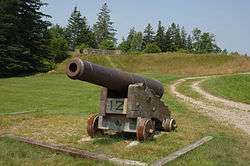
In early July 1779, Francis McLean left Halifax and led a British naval and military force into Castine's commodious harbor, landed troops, and took control of the village. He began erecting Fort George on one of the highest points of the peninsula. Alarmed by this incursion, the Commonwealth of Massachusetts sent the Penobscot Expedition to lay side to the fort and reclaim the territory.[31] The siege started on July 25 and lasted three weeks until the arrival of British commander George Collier who crushed the American expedition. (The British held New Ireland, the planned loyalist homeland, until the end of the war. Instead, the British divided Nova Scotia and named the new Loyalist homeland New Brunswick.)[32]
At the end of 1779, the British at Halifax experienced some significant losses. In December 1779 the schooner Hope wrecked near the Sambro Island Light on the Three Sisters Rocks. Captain Henry Baldwin and six other crew were killed. Weeks later, 170 British sailors were lost when two vessels – North and St Helena – were wrecked in a storm when entering Halifax harbour.[32][33]
On 10 July 1780, in the Battle off Halifax, the British privateer brig Resolution (16 guns) under the command of Thomas Ross engaged the American privateer Viper (22 guns and 130 men) off Halifax at Sambro Light. In what one observer described as "one of the bloodiest battles in the history of privateering", the two privateers began a "severe engagement"[34] during which both pounded each other with cannon fire for about 90 minutes.[35][36] The engagement resulted in the surrender of the British ship and the death of up to 18 British and 33 American sailors.[lower-alpha 3]
In May 1781, the local Nova Scotia militia defeated American privateers in the Battle off Cape Split.[38][39] The British and French also clashed in the Naval battle off Cape Breton.[40] Finally, the privateers returned in the Raid on Annapolis Royal (1781).[41] In the final year of attacks on Nova Scotia, the American privateers fought in the Naval battle off Halifax and the Raid on Lunenburg (1782).[42][43]
Defence regiments
.png)
To guard against American privateer attacks, the 84th Regiment of Foot (Royal Highland Emigrants) (2nd battalion) was garrisoned at forts around Atlantic Canada. Fort Edward (Nova Scotia) in Windsor, Nova Scotia was the Regiment's headquarters to prevent a possible American land assault on Halifax from the Bay of Fundy. Also raised in Nova Scotia were the Royal Fencible American Regiment and the Royal Nova Scotia Volunteer Regiment. The King's Orange Rangers defended Liverpool, the second largest settlement in the colony. The Hessians also served in Nova Scotia for five years (1778–1783). They protected the colony from American privateers, such as when they responded to the Raid on Lunenburg (1782). They were led by Baron Oberst Franz Carl Erdmann von Seitz. There were 5000 British troops in Nova Scotia by 1778.[47]
Naval defence
In terms of naval force, along with issuing letters of marque for different privateering vessels, in 1776 the Government also retained the armed schooner Loyal Nova Scotian (8 guns, 28 men).[48][49][50] On Nov. 26, 1776, under the command of John Alexander, the Loyal Nova Scotian re-captured the privateer Friendship.[51] In 1778, the vessel was ordered to Lunenburg and then retired.[52][53] By 1779, Nova Scotia's naval defence had four vessels: a frigate (32 guns), sloop of war (18 guns), armed schooner (14 guns) and another armed schooner (10 guns).[54] These ships were named Revenge (18 guns,50 men, Captain Jones Fawson; Captain James Gandy), Buckram (8 guns, 20 men, Captain Archibald Allardice) and the armed schooner Insulter (Captain John Sheppard), all acting under government orders.[19] There were numerous other privateers supported by local villages: Enterprise (Liverpool), Hero (100 men, 16 guns, Captain Bailey, Chester),[55] Arbuthnot, The David, Mowatt, Lady Hammond, The Fly, Sir George Hammond, Lancaster, Dreadnought (Captain Dean of Liverpool), The Success, The Lively, the sloop Howe, and the ship Jack.[56]
In 1778, Nova Scotians ships had taken at least 48 prizes and four recaptures. Between 1779 and 1781, they captured 42.[56]
Treaty of Watertown
In 1776, the Mi'kmaq signed the Treaty of Watertown, agreeing to support the American Patriots against the American Loyalists. Three years later, on 7 June 1779, the Mi'kmaq "delivered up" the Watertown treaty to Nova Scotia Governor Michael Francklin and re-established Mi'kmaw loyalty to the British.[57][58] After the British resounding victory over the American Penobscot Expedition, according to Mi'kmaw historian Daniel Paul, Mi'kmaq in present-day New Brunswick renounced the Watertown treated and signed a treaty of alliance with the British on 24 September 1779.[59][60][61]
American Revolution gallery
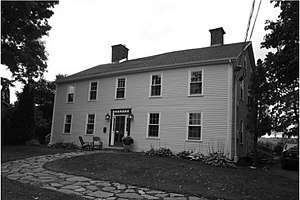
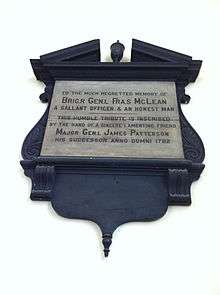 Francis McLean established and defended New Ireland (Maine), Plaque, St. Paul's Church (Halifax), Nova Scotia
Francis McLean established and defended New Ireland (Maine), Plaque, St. Paul's Church (Halifax), Nova Scotia Raid on Lunenburg (1782)
Raid on Lunenburg (1782)- Hatchment of Baron Oberst Franz Carl Erdmann von Seitz, St. Paul's Church (Halifax), Nova Scotia, d.1782
 Col Simeon Perkins
Col Simeon Perkins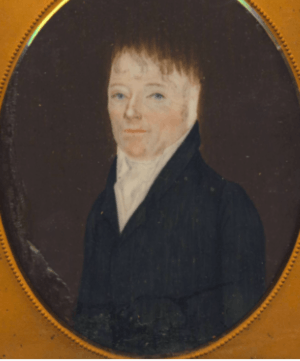 Jonathan Prescott
Jonathan Prescott
St. John's Island and Newfoundland

The population of St. John's Island (present-day Prince Edward Island), small compared to Nova Scotia, was only about 1215 in 1774.[62] Nova Scotia has been described as a 'shield' to the other two colonies, stopping much unrest from the American colonies from reaching them. St. John's Island during the time has been described as "a model colony".[63]
At the outbreak of the American Revolution, Phillips Callback was in charge of St. Johns Island.[lower-alpha 4] Thomas Gage began recruiting men to help defend Quebec against American attack; however, his efforts were hindered by a group of American revolutionaries living in Pictou, Nova Scotia. A group of about 150 American soldiers set out to attack ships bringing arms to the British.[64] Though they failed in their attempt, they arrived in Pictou, and from the Americans living there learned about recruiting efforts, and attacked Charlottetown. They threatened to set fire to the town but Callback convinced them to spare the town. Callback and Thomas Wright (the surveyor of the island) were taken prisoner.[65][66] The two hostages were eventually released, and made it back to the island on May 1, 1776.[67]
After the attack, an armed brig was sent to guard St. John's Island, and a militia was raised. The brig left when HMS Lizard arrived in September 1776. A fort was planned to better defend the town then Fort Amherst could. After Eddy's raid, the militia (which had only existed as 20 men previously) was raised to 80, and named The Loyal Island of St. John Volunteers. In 1778, five companies under Timothy Hierlihy were sent to better garrison the island. At the troops arrival, Callback was ordered to disband the "superfluous and expensive" militia. He ignored the orders. The feasibility of attacking St. John's was considered by the French navy.[68]
The Island, despite perceived danger, served mainly as a stopping point for British troops on their way out from Quebec, and British troops bringing captured privateers back. A group of 200 Hessians en route to Quebec spent a year on the Island. Work on the fort continued until Patterson (the governor) arrived in 1780. He saw the five companies and 8,000 pounds which had been spent on fortifications as a colossal waste of money. Work was halted and the companies returned. Throughout the war, the Island was highly loyal, and endured few attacks.[69]
In 1765, Newfoundlands population was around 15,000, consisting largely of Irish immigrants.[62] As it was not technically a colony, Newfoundland did not pay the Stamp Act 1765 or Townshend Acts taxes. Despite having minor problems with the British government, the island "preserved a tone of exemplary loyalty." The island maintained nearly no defenses, and as such, Esek Hopkins was sent to attack Newfoundland. In September 1776, a group of several privateers took three or four ships, and plundered about ten others. In 1777, HMS Fox was captured, and several months later retaken. The following year, many other ships were attacked, particularly by Minerva.[70]
Upon the arrival of Richard Edwards, many privateers were defeated, and by 1779, very few were left. Edwards ordered cannon distributed to allow towns to defend themselves against attack. In early 1780, at Mortier, a privateer was repulsed by the town. That same year, a fleet, led by Edwards, of nine ships, captured six privateers. Fourteen were captured the next year. Several companies were raised, and several hundred soldiers left to fight with British troops.[71]
Both islands had minor food shortages, particularly after a fire on St. Johns burnt 35 houses, and many stores of food. The fishing industries in both were reduced to "low and miserable state[s]," and the general population of both decreased as well. An outbreak of robberies occurred as people needed various resources. A riot occurred in 1779 on St. John's, in which one person was killed.[71]
Loyalist settlements
About 20,000 Loyalists fled to Nova Scotia during and after the American Revolution. Most came from the state of New York.[72][73] The three largest settlements being Saint John River Valley, Digby, Nova Scotia and Shelburne, Nova Scotia. Cape Breton was a separate colony as received 3150 Loyalists. Ile St. Jean received 300 Loyalist refugees.[74] The British returned New Ireland to the Americans and the territory in Maine entered the control of the newly independent American state of Massachusetts. Those from New Ireland settled St. Andrews, New Brunswick. With the Loyalist homeland gone, Nova Scotia was divided to accommodate the Loyalists: both New Brunswick and Cape Breton were created as separate colonies for the Loyalists (Cape Breton returned to Nova Scotia in 1820).
There are many Loyalists who settled in Halifax and were buried in the Old Burying Ground (Halifax, Nova Scotia), including a number of Black Loyalists who have unmarked graves.[75]
Numerous British soldiers became Loyalists and their regiments settled in various communities across Nova Scotia.[76] The Royal Fencible American Regiment settled in Wallace, Nova Scotia. The Second Battalion of the 84th Regiment of Foot (Royal Highland Emigrants) settled in Municipality of East Hants, particularly at Kennetcook, Nova Scotia.
There were three Regiments that settled Digby, Nova Scotia: New Jersey Volunteers, the Royal Garrison Battalion and the Loyal American Regiment.[77] Black Pioneers settled in Brindley Town, (now Acaciaville, Nova Scotia).[78]
The Black Pioneers settled at Annapolis Royal, Nova Scotia. The Hessians also settled Annapolis Royal and other places in Nova Scotia.[79][80]
At Guysborough, Nova Scotia there were six regiments that settled: Jamaica Rangers, Jamaica Volunteers, Negro Horse, Royal North Carolina Regiment, Duke of Cumberland's Regiment and the North Carolina Highlanders. East Country Harbour, Nova Scotia was settled by three regiments: the Royal North Carolina Regiment, the King's Carolina Rangers (see Joseph Marshall) and the South Carolina Royalists.[81][82]
The Royal Nova Scotia Volunteer Regiment settled Ship Harbour, Nova Scotia and Antigonish, Nova Scotia.
The King's Orange Rangers settled in Middleton, Nova Scotia.
Communities named after Revolutionary Leaders
- Parrsboro, Nova Scotia, John Parr
- Guysborough, Nova Scotia (Guy's borough), Guy Carleton, 1st Baron Dorchester)[83]
- Carleton Corner
- Carleton Village, Nova Scotia
- Birchtown, Nova Scotia, Brigadier-General Samuel Birch, compiler of the Book of Negroes
- Rawdon, Nova Scotia, Francis Rawdon-Hastings
- Digby, Nova Scotia, Admiral Robert Digby (Royal Navy officer)
- Abercrombie, Nova Scotia, General James Abercrombie
- Tiddville, Nova Scotia, Samuel Tidd, a private for Col. Beverley Robinson
- Gilbert Cove, Nova Scotia, Lt. Thomas Gilbert
- Barton, Nova Scotia, Lt. Col. Joseph Barton (military officer)
- Russell Lake, Nova Scotia, Nathaniel Russell
- Wentworth, Nova Scotia, Sir John Wentworth, 1st Baronet
- Wentworth Valley, Nova Scotia
- Wentworth Station, Nova Scotia
- Douglas, Nova Scotia, Sir Charles Douglas, 1st Baronet
- Seccombes Island, Nova Scotia, Rev. John Seccombe[84]
- Allendale, Nova Scotia, James Allen[85]
- Ballantynes Cove, Antigonish, (David Ballentine, 82nd Regiment)
- Balls Creek, Nova Scotia, (Ingram Ball, 33rd Regiment)
See also
Notes
- For other reasons why Nova Scotia didn't join in the rebellion see:
Cahill (1996), pp. 52–70
Stewart, Gordon Thomas; Rawlyk, George A. (1972). A People Highly Favoured of God: The Nova Scotia Yankees and the American Revolution. Archon. ISBN 978-0-208-01283-8.
Armstrong, Maurice (1946). "Neutrality and Religion in Revolutionary Nova Scotia". The New England Quarterly. 19 (1): 50–62. doi:10.2307/361206. JSTOR 361206. - Lieutenant Governor Sir Richard Hughes stated in a dispatch to Lord Germaine that "rebel cruisers" made the attack.
- There are varying reports on the number of casualties. Another source indicates that the Americans reported between 3 died (British reporting 30 American died), while British reported 8 killed and 10 wounded.[37]
- The governor was on a trip to England, and Callback, the Attorney General was left in charge.
References
- https://morethannelson.com/officer/henry-francis-evans/
- https://morethannelson.com/officer/sir-rupert-george/
- Rupert George's Obituary - married in Halifax
- George Family, p. 8
- Hanc, John (5 June 2017). "When Nova Scotia Almost Joined the American Revolution". Smithsonian.
- Kerr, Wilfred B. (September 1933). "The Stamp Act in Nova Scotia". New England Quarterly. 6 (3): 552–566. JSTOR 359557.
- Gwyn (2003), p. 56.
- Maclay, Edgar Station (1899). A History of American Privateers. D. Appleton and Company.
- "Naval Documents of the American Revolution" (PDF). United States Government Printing Office. 1966. pp. 445–446.
- Burke, Edmund (1780). An Impartial History of the War in America. London: R. Faulder. OCLC 6187693.
- Faibisy (1972).
- "To James Madison from Seth Harding, [ca. 12 July] 1790". National Archives and Records Administration.
- Cahill (1996), p. 52.
- Cahill (1996), p. 54.
- "Refugee Tract". Papers of the War Department. National Historical Publications and Records Commission. Archived from the original on 2018-11-14. Retrieved 2018-04-29.
- Armstrong, Maurice W. (1947). "The First Protestant Ordination in Canada" (PDF). The Dalhousie Review: 53–59.
- Goodwin, Daniel C. (1988). "From Disunity to Integration: Evangelical Religion and Society in Yarmouth, Nova Scotia, 1761–1830" (PDF). In Margaret Conrad (ed.). They Planted Well: New England Planters in Maritime Canada. Fredericton, New Brunswick: Acadiensis Press. pp. 190–200. ISBN 0-919107-20-6.
- History of the islands and islets in the Bay of Fundy, Charlotte County, New Brunswick: from their earliest settlement to the present time, including sketches of shipwrecks and other events of exciting interest by Lorimer, J. G. (John Gordon). 1876.
- Shortt, Adam; Doughty, Arthur G. (Arthur George) (February 12, 1914). "Canada and its provinces; a history of the Canadian people and their institutions". Toronto : Glasgow, Brook and company; [etc., etc.] – via Internet Archive.
- Nova Scotia Vice-Admiralty Court (1911), p. 75.
- Raymond, William O. (1905). Glimpses of the Past: History of the River St. John A.D. 1604–1784. Saint John, New Brunswick. p. 134.
- Nova Scotia. Vice-admiralty court, Halifax (February 12, 1911). "American vessels captured by the British during the revolution and war of 1812;". Salem, Mass., The Essex institute – via Internet Archive.
- Division, United States Naval History (February 12, 1964). "Naval Documents of the American Revolution: American theatre: June 1, 1777-July 31, 1777. European theatre: June 1, 1777-Sept. 30, 1777. American theatre: Aug. 1, 1777-Sept. 30, 1777". U.S. Government Printing Office – via Google Books.
- "Maximilian Jacobs".
- Mancke, Elizabeth (2005). The Fault Lines of Empire: Political Differentiation in Massachusetts and Nova Scotia, Ca. 1760–1830. Psychology Press. ISBN 978-0-415-95000-8.
- Collections of the Nova Scotia Historical Society. Vol. XX. Halifax: Wm. NacNab & Son. 1921. p. 17.
- "Massachusetts soldiers and sailors of the revolutionary war. A compilation from the archives". Boston, Wright and Potter Printing Co., State Printers. February 12, 1896 – via Internet Archive.
- Hannay, James. History of New Brunswick. Saint John, New Brunswick: J. A. Bowes. pp. 121–122.
- Murdoch (1866), p. 600.
- Sloan, Robert W. (1979). "New Ireland: Men in Pursuit of a Forlorn Hope, 1779–1784". Maine Historical Society Quarterly. 19 (2): 73–90.
- Bicheno, Hugh (2003). Rebels and Redcoats: The American Revolutionary War. HarperCollins Publishers. ISBN 978-0-00-739091-5.
- Murdoch (1866).
- Akins, Thomas B. (1895). History of Halifax city. Halifax: Nova Scotia Historical Society. p. 78.
- Simeon Perkins Diary. Thursday 13 July 1780
- Harold, Horwood; Butts, Edward (1987). Bandits & Privateers: Canada in the Age of Gunpowder. Doubleday Canada, Limited. ISBN 978-0-385-25110-5.
- Murdoch (1866), p. 609.
- Murdoch (1866), p. 608.
- Murdoch (1866), p. 614.
- Eaton, Arthur Wentworth Hamilton. The history of Kings County, Nova Scotia, heart of the Acadian land. Salem, Massachusetts: The Salem Press Company. p. 433.
- Gwyn (2003).
- Dunn, Brenda (2004). A History of Port-Royal-Annapolis Royal, 1605–1800. Nimbus. pp. 222–223. ISBN 978-1-55109-740-4.
- Salem Gazette, p. 11, 18 July 1782; Boston Post, 15 June 1782; and Hunt's Magazine, February, 1857, as cited by Allan, Gardner W. (1913). "Chapter 17". A Naval History of the American Revolution. Boston: Houghton Mifflin.
- MacMechan, Archibald (1924). "The Sack of Lunenburg". Sagas of the Sea. Dutton. pp. 57–72.
- Prenties, S. W. (Samuel Weller) (February 12, 1782). "Narrative of a shipwreck on the island of Cape Breton, in a voyage from Quebec 1780 [microform]". London printed : [s.n.] – via Internet Archive.
- Naval Chronicle. Vol. 11, p. 447
- Clarke, James Stanier; Jones, Stephen; Jones, John (February 12, 1805). "The Naval Chronicle". J. Gold – via Google Books.
- Murdoch (1866), p. 594.
- p. 399
- Division, United States Naval History (February 12, 1964). "Naval Documents of the American Revolution". Naval History Division, Department of the Navy – via Google Books.
- Nichols, George E. E. (1908). "Notes on Nova Scotian Privateers". Collections of the Nova Scotia Historical Society. XIII: 111–152 – via Provincial Archives of New Brunswick.
- Nova Scotia Vice-Admiralty Court (1911), p. 33.
- Faibisy (1972), p. 122.
- Clark, William Bell, ed. (1964). Naval documents of the American Revolution. Washington: Naval History Division, Dept. of the Navy. p. 424.
- Murdoch (1866), p. 602.
- Akins, Thomas B. (February 12, 1895). "History of Halifax city". Halifax : [Nova Scotia Historical Society] – via Internet Archive.
- "Provincial Archives of New Brunswick". archives.gnb.ca.
- Kidder, Frederic (1867). Military operations in eastern Maine and Nova Scotia during the revolution. Albany: Joel Munsell. p. 282.
- Murdoch (1866), p. 599.
- Murdoch (1866), p. 595.
- Paul, Daniel N. (2000). We Were Not the Savages: A Mi'kmaq Perspective on the Collision Between European and Native American Civilizations (2nd ed.). Fernwood. pp. 169–170. ISBN 978-1-55266-039-3. (includes full text of both treaties).
- Kidder, Frederic (1867). Military operations in eastern Maine and Nova Scotia during the revolution. Albany: Joel Munsell. p. 318.
- Kerr (1941), pp. 9–10.
- Kerr (1941), p. 105.
- Kerr (1941), p. 106.
- Faibisy (1972), p. 43.
- Stark, James Henry (1972). The Loyalists of Massachusetts And the Other Side of the American Revolution. Library of Alexandria. ISBN 9781465573919.
- Kerr (1941), p. 107.
- Kerr (1941), pp. 107–108.
- Kerr (1941), pp. 109–111.
- Kerr (1941), pp. 111–114.
- Kerr (1941), pp. 115–123.
- Flick (1901), p. 176.
- Neil MacKinnon. This Unfriendly Soil: The Loyalist Experience in Nova Scotia, 1783-1791. McGill-Queen's Press. 1986.
- Flick (1901), p. 174.
- "Loyalists / Black Loyalists". Canadian Confederation. Library and Archives Canada. 2 May 2005.
- "Distribution of Troops in Nova Scotia" (PDF).
- "Remembering the Loyalists" (PDF). www.uelac.org. Retrieved 2020-02-12.
- "Resource" (PDF). www.uelac.org. Retrieved 2020-02-12.
- The Hessians of Nova Scotia, compiled by Johannes Helmut Mertz (1997).
- Hessians in Annapolis County, by Ira Maxwell Sutherland (1956). BA thesis on the disbanded German soldiers granted land in Clements township after the American Revolution.
- "The Historical Unit - King's Carolina Rangers". sites.google.com.
- "Genealogy" (PDF). guyscogene.net. Retrieved 2020-02-12.
- "Data" (PDF). brian.mcconnell.tripod.com. Retrieved 2020-02-12.
- Brown, Thomas J. (February 12, 1922). "Place-names of the Province of Nova Scotia". [Halifax, N.S. Royal Print. & Litho.] – via Internet Archive.
- "Nova Scotia Archives - Place-Names and Places of Nova Scotia". Novascotia.ca. Retrieved 2020-02-12.
Bibliography
- Records of the Vice Admiralty Court - American Revolution and War of 1812
- Neil MacKinnon. This Unfriendly Soil: The Loyalist Experience in Nova Scotia, 1783–1791. McGill-Queen's Press. 1986.
- Nova Scotia on the road to the Revolution
- Kerr, Wilfred Brenton (1941). The maritime provinces of British North America and the American Revolution. Sackville, N.B.: Busy East Press.CS1 maint: ref=harv (link)
- Flick, Alexander Clarence (1901). Loyalism in New York during the American revolution. New York: The Columbia University Press.CS1 maint: ref=harv (link)
- Gwyn, Julian (2003). Frigates and Foremasts: The North American Squadron in Nova Scotia Waters, 1745-1815. UBC Press. ISBN 978-0-7748-0911-5.CS1 maint: ref=harv (link)
- Murdoch, Beamish (1866). A History of Nova-Scotia, Or Acadie. Vol. II. Halifax: J. Barnes.CS1 maint: ref=harv (link)
- Nova Scotia Vice-Admiralty Court (1911). American vessels captured by the British during the revolution and war of 1812. Salem, Massachusetts: The Essex institute.CS1 maint: ref=harv (link)
- Rawlyk, George A. "The American Revolution and Nova Scotia Reconsidered". The Dalhousie Review: 379–394.
- Cahill, Barry (Autumn 1996). "The Treason of the Merchants: Dissent and Repression in Halifax in the Era of the American Revolution". Acadiensis. 26 (1): 52–70.CS1 maint: ref=harv (link)
- Faibisy, John Dewar (1972). Privateering and piracy: the effects of New England raiding upon Nova Scotia during the American Revolution, 1775-1783 (Thesis). University of Massachusetts Amherst.CS1 maint: ref=harv (link)
- Loyalists - New Hampshire to Annapolis. 1916.
- Weld, Allen. Massachusetts Privateers in the American Revolution. 1911
- Marines in the Revolution :a history of the Continental Marines in the American Revolution, 1775-1783
- Adam Short - Nova Scotia and the American Revolution. 1914.
- American Privateers off Nova Scotia, Naval Documents of the American Revolution, p. 1204
- Military operations in eastern Maine and Nova Scotia during ... Kidder, Frederic, 1804-1885.
- Naval Documents and the American Revolution. Vol. 1-9. Naval History and Heritage Command
